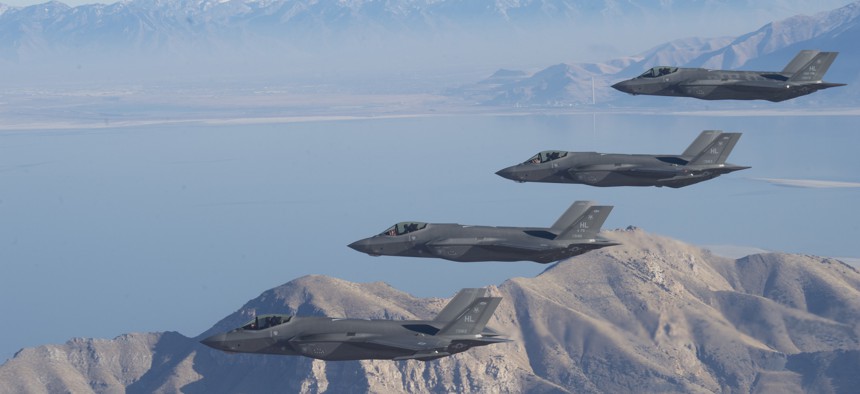
A formation of F-35 Lightning IIs from the 388th Fighter Wing and 419th FW stationed at Hill Air Force Base, Utah, perform aerial maneuvers during as part of a combat power exercise over Utah Test and Training Range, Nov. 19, 2018. U.S. Air Force / Staff Sgt. Cory D. Payne
Price of F-35 Falls, But Not as Much As Pentagon Hoped
Defense officials say the cost of the plane’s engine is not declining as much as the airframe itself. The engine maker says it already dropped by half.
The price of the F-35 Joint Strike Fighter is falling, just not as much as Pentagon officials had hoped, according to new data released Tuesday.
The cost of the plane’s engine, made by United Technologies’ Pratt & Whitney, is not declining at the same rate as the rest of the Lockheed Martin aircraft, F-35 program director Air Force Lt. Gen. Eric Fick told reporters Tuesday at the Pentagon.
But Pratt & Whitney officials say they already cut the price of the F135 engine — by more than half — from 2009 to 2018. Now, the company is reducing the price by single-digit percentages from order to order, company spokesman John Thomas said Tuesday. Deeper cost reductions would be possible only through major technology and design upgrades, he said.
The pricing new data was released one day after the U.S. Defense Department announced it finalized a $34 billion deal with Lockheed Martin for 478 F-35s.
Related: Price Drop: Lockheed Pitches $80M F-35A to Pentagon
Related: Extra-Long Sustainment Contracts Are Lockheed’s Latest Bid to Cut F-35 Costs
Related: How We Tamed the F-35’s Spiraling Costs — and Created a Model for Controlling Waste
When Pentagon officials announced in June that they had reached a “handshake agreement” with Lockheed for the 478 F-35s, the largest purchase lot of the plane to date, they said they expected an “approximate average of 15% URF reduction across all variants.” URF is “unit recurring flyaway” cost, which includes the price of the plane and its engine.
On Tuesday, Fick said the actual decline in URF for the batch was roughly 12 to 13 percent.
The price tags for all three versions of the plane are expected to keep falling over the next three years. The F-35A, the version flown by the U.S. Air Force and most allies, is expected to drop from $89.2 million to $77.9 million in 2022. The F-35B, the Marine Corps’ vertical landing version, is expected to fall from $115.5 million to $101.3 million. The Navy’s carrier-capable F-35C is expected to fall from $107.7 million to $94.4 million.
“This agreement represents our continued commitment to reduce F-35 cost aggressively, incentivize industry to meet required performance and deliver advanced capabilities to our warfighters at the best value to taxpayers,” Ellen Lord, the defense undersecretary for acquisition and sustainment, said during a Tuesday briefing at the Pentagon.
Lockheed has improved on-time delivery rate to 96%, up from 64% last year, Lord said.
The Pentagon is “laser focused on driving cost out, quality up and achieving timely deliveries of our capability to our warfighters,” Lord said at a Tuesday press briefing.

2017 comparison of F-35 costs over time
NEXT STORY: Microsoft Wins Massive JEDI Cloud Contract
